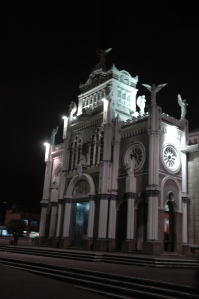More Info on Costa Rican Mystery Spheres
Original: http://www.ticotimes.net/daily_paid/dailynewsarchive/2010_08/081810.htm#story5
Ifigenia Quintanilla will shine some light on one of Costa Rica’s oddest mysteries Wednesday.
In the 1940s, hundreds of pre-Columbian stone spheres were discovered throughout the Southern region of Costa Rica and in the north of Panama. The creation of these almost perfectly round spheres and their purpose remains a mystery to archaeologists.
Quintanilla, a Costa Rican archaeologist who has studied the mysterious monoliths for 17 years, will explain what researchers know about these artifacts and what makes them so impressive at 3 p.m. on Wednesday at the Hotel Casa Roland in Rohrmoser, in western San José. The presentation is sponsored by the Costa Rican Association of Tourism Professionals (Acoprot).
“We have known about the existence of the spheres for many years,” said Patricia Duar, executive director of Acoprot. “But very few of us really know why they are there or their meaning.”
Quintanilla is one of the most knowledgeable experts on these stones. She’s researched for them for two decades and even wrote a book on the mystery called “Esferas Precolombinas de Costa Rica” (Pre-Columbian spheres of Costa Rica ).
The spheres can be as small several centimeters in diameter to massive 15-ton boulders. But all of them have an uncanny spherical shape. Some of the spheres have symbols sculpted on them.

In March, Costa Rica presented a bid to have the spheres included by th e United Nations Educational, Scientific and Cultural Organization (UNESCO) on the list of World Heritage sites. Cultural or natural sites or monuments can make the list if UNESCO deems them to have “outstanding universal value,” according to the Convention Concerning the Protection of the World Cultural and Natural Heritage (TT, March 15 ).
To reserve a seat at the conference send an e-mail to Mónica Monge at[email protected] or call Acoprot at 2280-5375. Admission is free.
What: Ifigenia Quintanilla on the Mystery of Costa Rica’s pre-Colombian stone spheres
Where: Hotel Casa Roland, Rohmoser
When: 3 p.m.
Cost: Free
NOTE from Nick Halverson

These spheres are found throughout the entire southern pacific region of Costa Rica – especially in Palmar Sur. Palmar Sur’s “Central Park” has approximately 30 of the spheres – all at least one meter in diameter. It is not unusual to see these spheres in front of homes and restaurants in Uvita, Ojochal, San Isidro del General and Palmar Sur/Palmar Norte.
The closest spheres to residents of The Village of San Buenas is at the municipality building in Cortez. Simply take a right at the fork in the road at the hospital turn off. Go straight approximately 2 km and the Osa Municipality building will be on your right.







